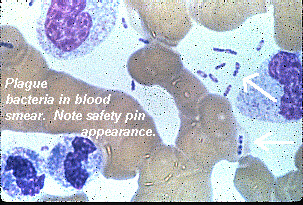Bubonic plague pathophysiology: Difference between revisions
| Line 4: | Line 4: | ||
==Overview== | ==Overview== | ||
{{#ev:youtube|pRZYb2Jl22g}} | |||
==Classification== | ==Classification== | ||
Revision as of 17:47, 28 February 2012
|
Bubonic plague Microchapters |
|
Diagnosis |
|---|
|
Treatment |
|
Case Studies |
|
Bubonic plague pathophysiology On the Web |
|
American Roentgen Ray Society Images of Bubonic plague pathophysiology |
|
Risk calculators and risk factors for Bubonic plague pathophysiology |
Editor-In-Chief: C. Michael Gibson, M.S., M.D. [1] Michael Maddaleni, B.S.
Overview
{{#ev:youtube|pRZYb2Jl22g}}
Classification
Yersinia was formerly classified in the family Pasteurellaceae, but based on DNA- DNA hybridization similarities to ''Escherichia coli'', the Yersinia group has been reclassified as members of the Enterobacteriaceae family (Farmer, 1995). Differentiation of the Enterobacteriaceae family members is based on biochemical and antigenic profiles. More recently, nucleic acid techniques have been applied to assist the definition of genera and species within this family; hence, as more techniques are applied, newly defined genetic relationships sometimes lead to changes in classification. Though there are 11 named species in the genus Yersinia, only 3 are considered important human pathogens: Y. pestis, the etiologic agent of plague, and the enteropathogenic strains, Y. pseudotuberculosis and Y. enterocolitica. Y. pseudotuberculosis is the closest genetic relative to Y. pestis but can be distinguished from the plague bacteria by its clinical manifestations and by laboratory test results. Both Y. pestis and Y. pseudotuberculosis do not frequently infect humans in contrast to Y. enterocolitica, which may be more commonly found in clinical specimens.

